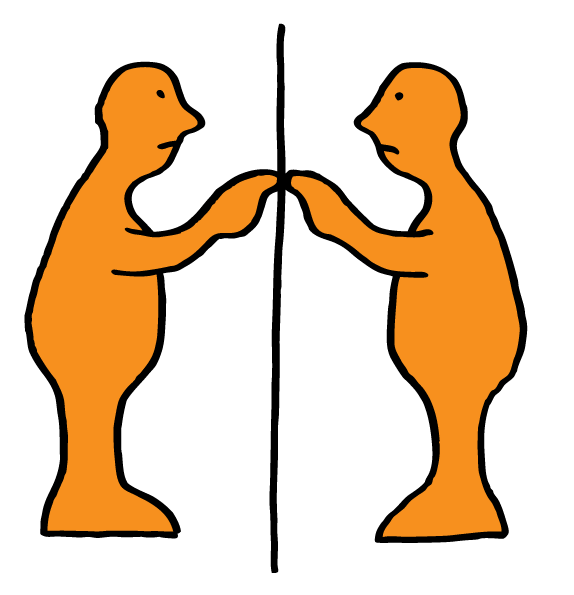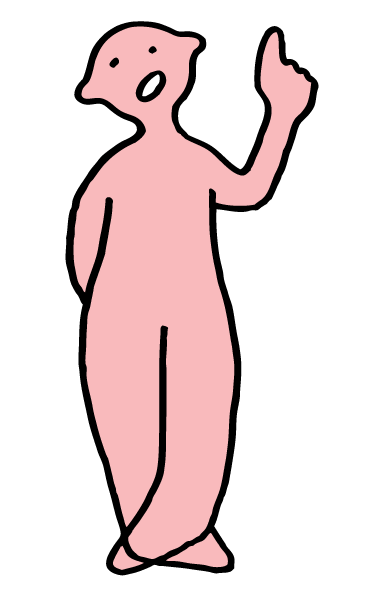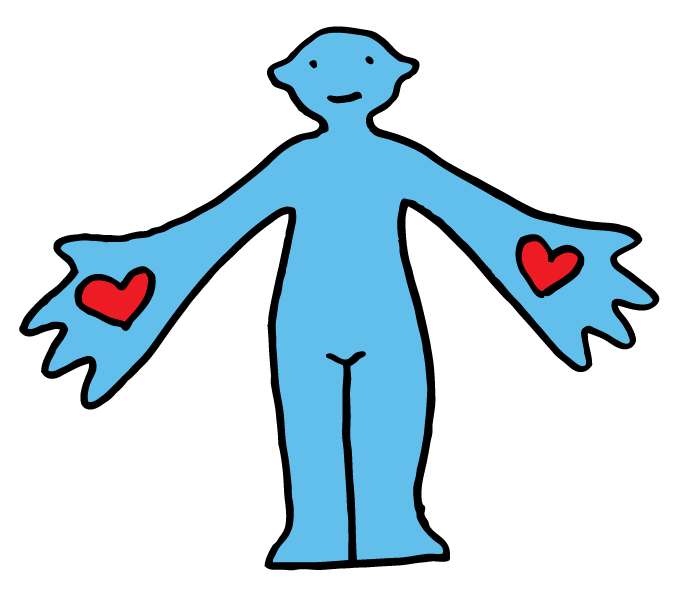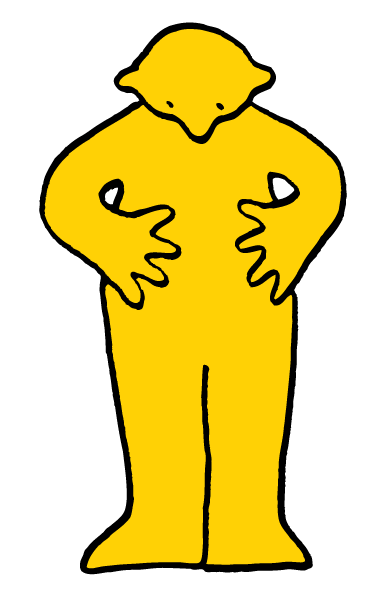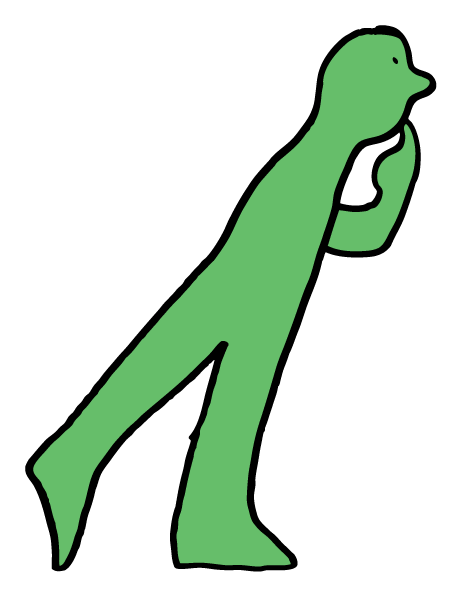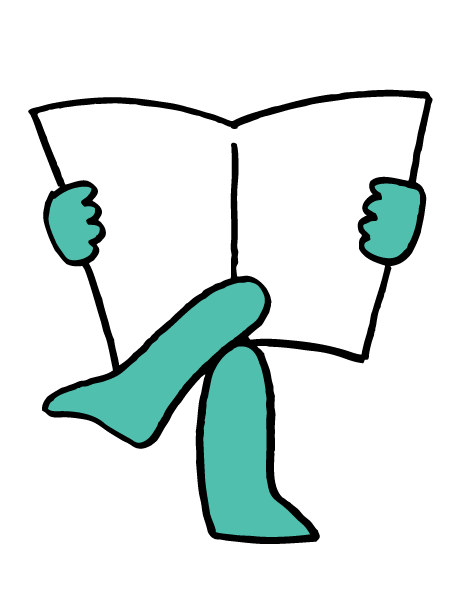

DANCE AND MOVEMENT THERAPY AS A SUCCESSFUL INTERVENTION REDUCING SYMPTOMS OF DEPRESSION AND ANXIETY
According to the American Dance Therapy Association (ADTA) dance and movement psychotherapy is a therapeutic use of movement and dance in the creative process with the aim to further the emotional, cognitive, social and physical integration of the individual. As body-oriented branches of psychotherapy, dance/movement psychotherapy advocates the necessity of including the body in psychotherapy.
In dance/movement psychotherapy, we put the focus on the body, its look, position and the so-called blockage and sensations in the body, but also to the way of the client’s movement (including every type of movement from breathing pattern, gesticulation, mimics, muscle tension etc). The basic assumption is that body movements reflect the inner state, so the changes in movement patterns lead to the changes in mental patterns. In dance/movement psychotherapy, psychotherapists base their opinions on Laban Movement Analysis where a movement can be analysed through movement factors, that is the ways in which a specific movement is performed. If we take into consideration time, a movement at its final stage can be sudden or sustained. With regard to space, a movement can be direct or indirect, with regard to weight, strong or light (i.e. tense or relaxed), and with regard to flow bound or free. To simplify, we can relate the four abovementioned movement factors-time, space, flow and weight (i.e. force) with inner psychological state of the individual- space to thinking, time to bringing decisions, flow to feelings and weight to identity.
At first glance it may seem strange to relate the movement with the mental state of the individual, but, for example, if we look at the state and movements of our body when we are angry or happy, we will notice that when we are happy, out movements are more often free (flow) and light (weight, i.e. force), whereas when we are angry our movements are bound (flow) and strong, tense (weight, force).
Dance/movement psychotherapists work with clients on their movement patterns and gradually increase their range of motion. On the other hand, through body and movement they influence the expansion of different behaviour, thinking and coping patterns. To put it simply, in dance/movement psychotherapy it is believed that emotions will be triggered if our body is moving and vice versa- influence the body through emotions. Dance/movement psychotherapy can be seen as one of four expressive arts therapies with drama, art and music therapy.

Vedrana Kurjan Manestar
educator, Gestalt Psychotherapist
dance and movement therapy


Dance/movement psychotherapy is used with a wide range of clients with different disabilities because of the possibility of communication with clients on the non-verbal level, the release and resolution of repressed contents locked up and written in the body in a form of a disease or tension. As the part of my education about dance/movement psychotherapy is the clinical practice I’m doing in the Psychiatric Clinic with the patients suffering from depression and anxiety, I would focus more on this subject.
Studies show, according to the World Health Organisation, that depression affects 121 million of people around the world and it is one of the leading factors of disability as a cause of productivity loss in the world (Koch S. and all, 2007).
The US public health system estimated that the cost of depression treatment exceeded the cost of heart diseases treatment (Greenberg, Stiglin, Finkelstein & Berndt, 1993).
Therefore, depression requires high social and financial costs so discovering financially acceptable, non-aggressive and effective methods of treatment is the main aim of public health service. The results of numerous studies suggest the positive impact of dance/movement psychotherapy on different symptoms of depression such as lethargy, fatigue, lifelessness, pointlessness, lack of goals and strength to cope with life (Koch, S and all, 2007).
The cause of anxiety disorders can be a wide range of factors from biochemical imbalance to conflict and early childhood trauma. All these causes can be divided into four categories- psychodynamic, behavioural, cognitive and biochemical.
Dance/movement therapy involves techniques that change all four levels of the disease causes. Relaxation techniques, focus on bodily sensations, active imagination and drama are some of the activities that help with anxiety disorders and are used in dance/movement therapy.
Anxiety is a disorder that manifests itself in physical symptoms such as rapid pulse, short breath, trembling and irritability. Other diagnoses may also be the part of the clinical picture, such as phobia, post-traumatic stress disorder and obsessive-compulsive disorder. A panic attack can also be the part of the anxiety disorder clinical picture. A panic attack can be identified as sudden, overwhelming fear which occurs abruptly.
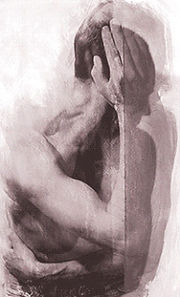
THE RELATIONSHIP BETWEEN ANXIETY EXPERIENCE AND ITS PHYSICAL EXPRESSION
In her article, Fiasco, P (1993) describes the results of her research which examined the relationship between the experience of anxiety and the description of the physical expression of anxiety at a particular moment. Ten professional dancers and ten amateurs, five men and five women in each group, participated in this study. They were asked to describe two situations in which they felt anxiety and then to demonstrate physically their experience of anxiety.
Research showed that participants from all categories (women and men amateurs and women and men professional dancers) expressed anxiety through four usual body areas- chest, neck, abdomen and back which may constitute reliable criteria for defining anxiety by physical symptoms. This research supports the usefulness of defining anxiety by bodily symptoms.
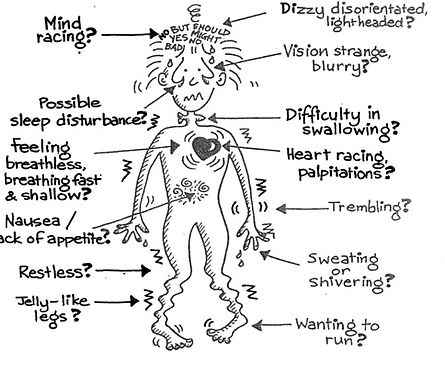

THE EFFECTIVENESS OF DANCE/MOVEMENT PSYCHOTHERAPY WITH PATIENTS SUFFERING FROM DEPRESSION
S.C. Koch and associates (2007) examined the specific effects of dance intervention to reduce depression. The study involved 31 patients from a psychiatric hospital in Heidelberg (18 women and 13 men). All these patients were diagnosed with depression as a main or secondary diagnosis. The patients- respondents were divided into three groups. One group was involved in dance therapy, the other in listening to the music, and the third in stationary bicycle exercise.
In dance therapy, participants were dancing together circle dance with small vertical jumps (Kestenberg theory anticipates the sense of joy caused by the use of jumping rhythms). In the group that was listening to the music, the participants were listening to the same music as the dancing group sitting relaxed with their feet on the floor. The third group of patients-participants exercised on a stationary bicycle to the same level their pulse was as fast as of the dancing group.
Taking into consideration a small sample, the results of this research are encouraging and of great help in determining priorities of the future studies in the use of dance/movement psychotherapy with psychiatric patients. Depression has considerably reduced in the participants in the dancing group, while depression level has not changed in the patients in the other two groups. Furthermore, in the dancing group, there was an increase in vitality of the patients to a higher degree than in the other two groups. The biggest changes in the dancing group were greater motivation, strength, energy and pleasure. Depression, lifelessness, anxiety and fatigue were reduced. This study is one of the first attempts to understand the specific factors influenced by dance psychotherapy in the treatment of psychiatric patients who were diagnosed with depression. Although the authors expected benefits of all three interventions, dance proved to be the only means that has significantly reduced the level of depression.

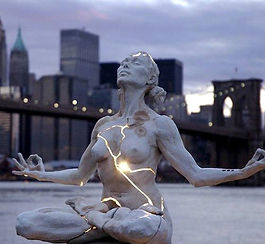
The improvement was more significant in men than in women and was more significant in the patients with the highest level of depression. The authors concluded that the benefits of dance/movement psychotherapy are greater for the patients with the highest level of depression.
They emphasise that the secondary effects of dance/movement psychotherapy are, unlike pharmacotherapy, positive. While medications can cause fatigue, changes in muscle tonus and nervousness, dance/movement psychotherapy impacts the body in a positive and empowering way and leads to secondary results, such as the prevention of cardiovascular diseases, reduction of anxiety and so on.
The authors state that different studies suggest that dance/movement psychotherapy is far more effective than other therapies regarding the improvement of the body image and emotion regulation in patients suffering from mental or psychosomatic disorders.
The same authors claim that with intensive dance/movement psychotherapy intervention at the period from two to three months 45 patients with diagnosed depression in daily psychiatric institution with psychotherapeutic treatments shows positive effects of dance/movement psychotherapy on body movements, self-perception, perception of the relationship with other people and their own biography.
Dance/movement psychotherapy is an approach that is often very attractive to female patients. The expected products of dance/movement therapy for female patients are the improvement of their body image and their mood, and the encouragement of the libidinal aspects of gender roles (happiness, lust).
The results of some research suggest that dance/movement psychotherapy stabilises the sympathetic nervous system. Dance/movement psychotherapy is effective in the beneficial modulation of serotonin and dopamine and in the treatment of psychological disorders in adolescents suffering from mild depression.
Unfortunately, in our psychiatric hospitals dance/movement therapy is not available (in any case, not by educated and certified psychotherapists) although it is very common in the world.
I hope the education of the first students of dance/movement psychotherapy will lead to significant achievements in the region.
REFERENCES:
Sabine C. Koch, PhD, MA, Katharina Morlinghaus, Thomas Fucks, PhD, MD The University of Heidelberg, Department of Psychology, The joy dance – Specific effects of a single dance ingtervention on psychiatric patients with depression, The Arts in Psychotherapy 34, 2007, pp 340 – 349
Fiasca, P.: A research Study on Anxiety and Movement, American Journal of Dance Therapy, Fall/Winter 1993, Volume 15, issue 2, pp 89-105
If anxiety is present to such an extent it can be interpreted adequately during the session, the clinician may presume that anxiety is associated with the memories preserved in some of the abovementioned body areas. This information enables the therapists to understand their clients better and make more adequate plan and treatment.
From another perspective, this research suggests that therapists can use their own sensations during the session to analyse the countertransference and to check their own reaction to the client examining which part of their body responds to the client's problem. However, even though this research does not take it into account, we should bear in mind that in our culture the transfer of knowledge relies strongly on the concept and language. Articulation and the transfer of acquired "knowledge" based on sense experience- perception are at best of secondary importance in our culture, and in the process of acquiring knowledge are often least significant.
On the other hand, the question is whether the knowledge about the body can be adequately transferred through the conceptual linguistic meanings. These questions open the complex philosophical discussion about the possibilities of human coexistence on tactile and not completely explained aspects of the body knowledge which cannot be articulated through the conceptual (notional) and linguistic analysis. Therefore, the author believes that psychotherapists and clients would have great benefits in the clinical work if both therapists and clients became aware of the mind-body interaction and paid more attention to this in their work.
The author of the text considers that many psychosomatic diseases could be managed and neurosis reduced. If we take into consideration the fact that, unlike animals, people suffer from existential illnesses, we could find one of the causes of human suffering in the great power of our minds. Despite all its benefits, the problem arises when in the middle of particular pain and suffering this brilliant mind (in order to avoid suffering) steps away from the wisdom of the body to such an extent it leads to an illness.


